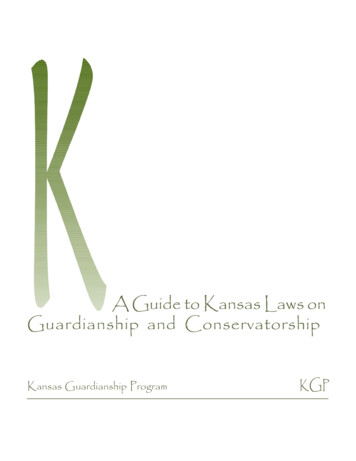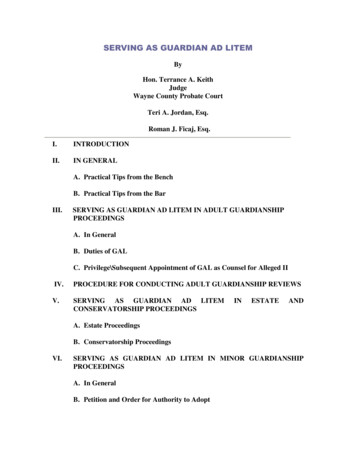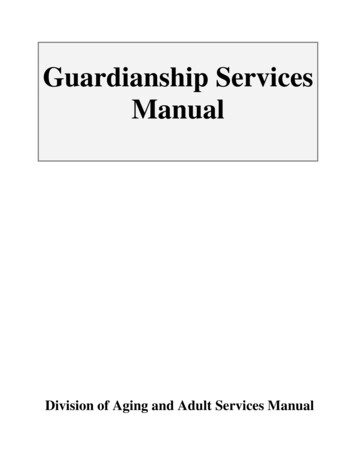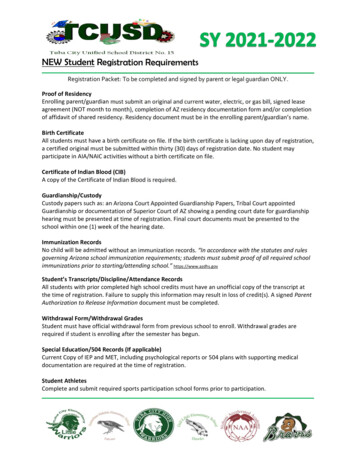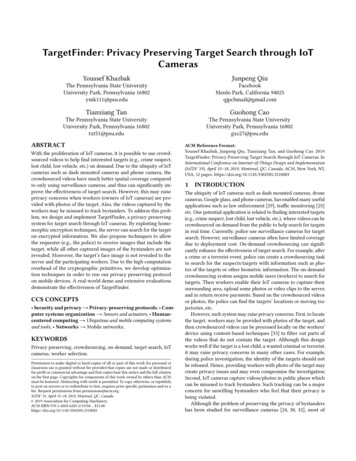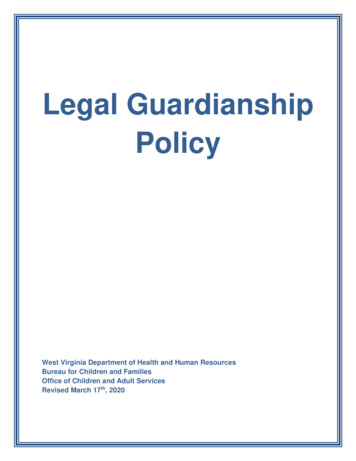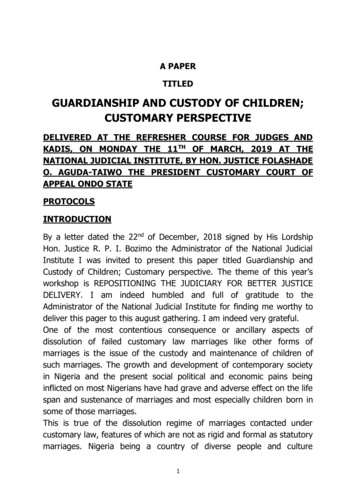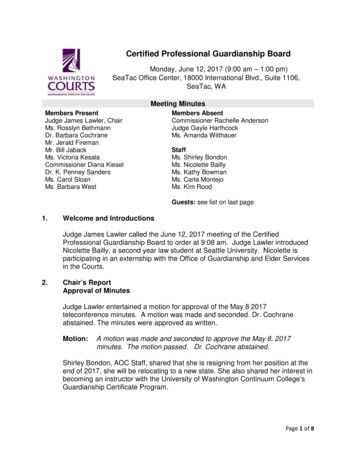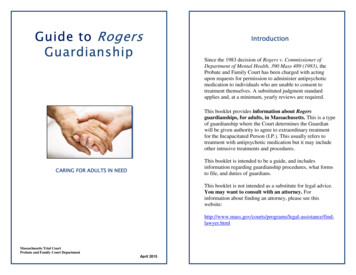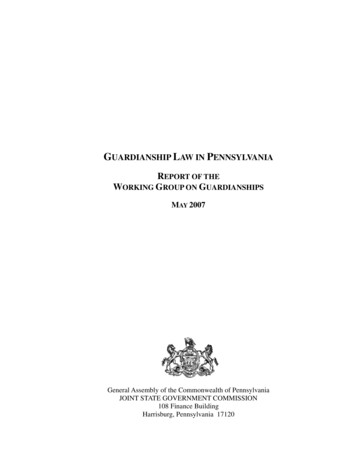
Transcription
GUARDIANSHIP LAW IN PENNSYLVANIAREPORT OF THEWORKING GROUP ON GUARDIANSHIPSMAY 2007General Assembly of the Commonwealth of PennsylvaniaJOINT STATE GOVERNMENT COMMISSION108 Finance BuildingHarrisburg, Pennsylvania 17120
The release of this report should not beinterpreted as an endorsement by themembers of the Executive Committee ofthe Joint State Government Commission ofall the findings, recommendations andconclusions contained in this report.JOINT STATE GOVERNMENT COMMISSIONROOM 108 FINANCE BUILDINGHARRISBURG PA 17120-0018Telephone 717-787-4397Fax 717-787-7020E-mail: jntst02@legis.state.pa.usWebsite: http://jsg.legis.state.pa.usThe Joint State Government Commission was created by the act of July 1, 1937(P.L.2460, No.459) as amended, as a continuing agency for the development offacts and recommendations on all phases of government for the use of the GeneralAssembly.-ii-
JOINT STATE GOVERNMENT COMMISSIONSenator Roger A. Madigan, ChairEXECUTIVE COMMITTEESenate MembersHouse MembersJoseph B. Scarnati, IIIPresident Pro TemporeDennis M. O’BrienSpeakerDominic F. PileggiMajority LeaderH. William DeWeeseMajority LeaderRobert J. MellowMinority LeaderSamuel H. SmithMinority LeaderJane Clare OrieMajority WhipKeith R. McCallMajority WhipMichael A. O’PakeMinority WhipDavid G. ArgallMinority WhipMichael L. WaughChair, Majority CaucusMark B. CohenChair, Majority CaucusJay Costa, Jr.Chair, Minority CaucusSandra MajorChair, Minority CaucusMEMBER EX-OFFICIOSenator Roger A. Madigan, Commission ChairDavid L. Hostetter, Executive Director-iii-
WORKING GROUP ON GUARDIANSHIPSMembersMark MurphyDisability Rights Network of PAThe Honorable Glen R. Grell, ChairRonald Costen, Ph.D., Esq.Temple UniversityThe Honorable Stanley R. OttKristen SanduskyPA Homecare AssociationThe Honorable Stephanie DomitrovichLawrence A. FrolikUniversity of PittsburghSchool of LawSally L. Schoffstall, Esq.Ilene ShaneDisability Rights Network of PADrew GrivnaPennsylvania Guardianship ServicesAlan SmithHuntingdon-Bedford-Fulton AreaAgency on AgingCherstin HamelAdministrative Officeof Pennsylvania CourtsNeil E. Hendershot, Esq.Michael StaufferPA Department of Public WelfareLisa HeymanPA Department of Public WelfareHoward UlanPA Department of Public WelfareRobert HussarPA Department of AgingThe Honorable Carol L. Van HornAnne M. WantzPA Health Care AssociationNicholas J. LucianoPA Association of Non-ProfitHomes for the Aging (PANPHA)Michael J. WiltPA Association of CountyAffiliated Homes (PACAH)James F. Mannion, Esq.The Honorable Judith Moser, M.S.Registers of Wills & Clerks ofOrphans’ Court Association of PAMichael YantisPA Department of Health-v-
AlternatesAnna Marie BorroPA Department of AgingDan FellinPA Department of Public WelfareJames BubbPA Department of AgingDwayne HeckertPA Department of HealthDebra CarrollPA Department of AgingBradley JacobsRegisters of Wills & Clerks ofOrphans’ Court Association of PAJackie CunninghamPA Department of Public WelfareMichael JacobsPA Health Care AssociationNichole DuffyOffice of AdministrationGinny RogersPA Department of Public WelfareJennifer EbersolePA Department of HealthGlenn WilliamsPA Department of Public Welfare-vi-
-vii-
CONTENTSINTRODUCTION .1GUARDIANSHIP LAW IN PENNSYLVANIA .3Plenary and Limited Guardianships.3The Need for Guardianships .4Data Collection and Guardianship Reports.5Data Collection and JSGC Surveys .8Monitoring Guardians: Standards, Qualifications and Certification .10Funding .13Education and Training. 14Governmental Oversight.15Public Records, Access and Guardian Registry.16Reporting Requirements . 17General Observations and Policy Considerationson Reforming the Guardianship System .17SUMMARY OF STATUTORY RECOMMENDATIONS . 19PROPOSED AMENDMENTS TO 20 Pa.C.S. CHAPTER 55 .23TRANSITIONAL LANGUAGE .49-ix-
AREA AGENCIES ON AGING .51Background on the AAAs.51AAA Funding.52Survey Methodology.54Survey Results . 55SURVEY SENT TO THE AREA AGENCIES ON AGING .75PENNSYLVANIA ASSOCIATION OF COUNTY AFFILIATED HOMES . 79Background on the PACAH .79Survey Methodology.79Survey Results . 80SURVEY SENT TO THE MEMBERS OF THEPENNSYLVANIA ASSOCIATION OF COUNTY AFFILIATED HOMES . 97APPENDIX. House Resolution 131 of 2005 (Printer’s No. 1861) . 99-x-
INTRODUCTIONHouse Resolution 131 of 2005 (Printer’s No. 1861)1 directed the Joint StateGovernment Commission (JSGC) to review current guardianship statutes and programsand make findings and recommendations on their effectiveness in meeting the needs ofvulnerable incapacitated persons.The JSGC formed the Working Group onGuardianships, and Representative Glen R. Grell, the prime sponsor of House Resolution131, became the Chair. The working group consisted of professionals with expertise inguardianship law, including attorneys, judges, representatives of the court system,guardianship providers, advocates for disabled and older individuals, law professors andrepresentatives from Area Agencies on Aging (AAAs), the Pennsylvania Association ofNon-Profit Homes for the Aging (PANPHA), the Pennsylvania Association of CountyAffiliated Homes (PACAH), and the Pennsylvania Departments of Aging, Health andPublic Welfare.On January 26, 2006, the working group held its organizational meeting to discussthe scope of the study and the issues for consideration. The working group then heldsix subsequent meetings, on April 27, 2006; July 20, 2006; September 28, 2006;November 16, 2006; January 19, 2007 and March 28, 2007. Throughout its deliberations,the working group reviewed and discussed data and other background information,statutory law,2 bills before the General Assembly,3 case law, the JSGC report ofMay 1996,4 the Uniform Guardianship and Protective Proceedings Act,5 and guardianshipand court practices across the Commonwealth. In addition, the working group membersshared their expertise and personal experiences regarding guardianship practices andprocedures.1Infra, Appendix (pages 99-101) for House Resolution 131 of 2005.The working group focused on Chapter 55 (incapacitated persons) of Title 20 of thePennsylvania Consolidated Statutes (the Probate, Estates and Fiduciaries Code) as a basis for discussion ofguardianship law. However, special attention was also given to 20 Pa.C.S. Chapter 56 (powers of attorney)and other 20 Pa.C.S. provisions.3The working group focused on two pieces of legislation: House Bill 1647 of 2001 and HouseBill 2269 of 2005. House Bill 1647, on which no legislative action was taken, set forth the CommonwealthGuardianship Office Act and created a guardianship office to serve as guardian for certain incapacitatedpersons (i.e., a public guardian). House Bill 2269, which passed the House on October 24, 2006 but wasnot acted upon by the Senate, set forth the Adult Protective Services Act and provided for the protection ofabused, neglected, exploited or abandoned adults, through a statutory framework for protective services anda uniform statewide reporting and investigative system for such adults.4Report of the Subcommittee on Guardianships and Powers of Attorney of the Task Force andAdvisory Committee on Decedents’ Estates Laws (JSGC, May 1996), which recommended amendments to20 Pa.C.S. Chapter 55.5The Uniform Guardianship and Protective Proceedings Act (1997) was approved andrecommended by the National Conference of Commissioners on Uniform State Laws.2-1-
This report reflects the findings and recommendations of the working group,along with proposed legislation and official comments.6 The official comments may beused in determining the intent of the General Assembly.7 This report also containsbackground information on the AAAs and PACAH, including the surveys distributed bythe JSGC.8 Finally, this report contains working group policy considerations regardingdata collection, the monitoring of guardians, funding, education and training, governmentoversight, access to records and reporting requirements.96Infra, “Summary of Statutory Recommendations” (pages 19-21) and “Proposed Amendments to20 Pa.C.S. Chapter 55” (pages 23-47). Transitional language for the proposed legislation follows onpage 49.71 Pa.C.S. § 1939.8Infra, pages 51-77 for information regarding the AAAs and pages 79-98 for informationregarding PACAH.9Infra, pages 5-17.-2-
GUARDIANSHIP LAW IN PENNSYLVANIAPlenary and Limited GuardianshipsChapter 55 (incapacitated persons) of Title 20 of the Pennsylvania ConsolidatedStatutes (the Probate, Estates and Fiduciaries Code) governs guardianship procedures inPennsylvania. Under § 5512.1(a) (determination of incapacity and appointment ofguardian), the court shall consider the nature of any condition or disability that impairs anindividual’s capacity to make and communicate decisions, the extent of the individual’sincapacity, the individual’s need for guardianship services, the type of guardianshipneeded and the duration of the guardianship. The court may appoint a limited guardian ofthe person, a limited guardian of the estate, a plenary guardian of the person or a plenaryguardian of the estate.10 According to § 5512.1(a)(6), the court shall prefer limitedguardianship, consistent with the principle that the court should order the least restrictivealternative available.Act 24 of 1992,11 which amended 20 Pa.C.S. Chapter 55 to authorize bothguardianship support agencies and limited guardianships, was intended to make greateruse of limited guardianships and reduce the number of plenary guardianships. At thetime, the concept of the limited guardianship was viewed as a significant reform.Limited guardianships serve several useful purposes. They are appropriate incases involving individuals under the age of 60 who have a stable disability. In addition,a person may be more willing to serve as a limited guardian, knowing that he or she doesnot need to make all the decisions for an incapacitated individual.Although Act 24’s provisions regarding limited guardianships werewell-intentioned for public policy reasons, they have had minimal practical effect. Thevast majority of all guardianships are still plenary guardianships.1210Upon a finding that the person is partially incapacitated and in need of guardianship services,the court may appoint (1) a limited guardian of the person, with powers consistent with the court’s findingof limitations, which may include, among other things, the general care, maintenance and custody of theperson; or (2) a limited guardian of the estate, with powers consistent with the court’s finding oflimitations, which shall specify the portion of assets or income over which the guardian is assigned powersand duties. 20 Pa.C.S. § 5512.1(b) and (d). Only upon a finding that the person is totally incapacitated andin need of plenary guardianship services may the court appoint a plenary guardian of the person or plenaryguardian of the estate. 20 Pa.C.S. § 5512.1(c) and (e).11Act of April 16, 1992 (P.L.108, No.24).12According to data provided by the Administrative Office of Pennsylvania Courts in May 2005,92.4 percent of approved guardianship petitions were plenary while 7.6 percent were limited for the years2000 through 2004.-3-
Several reasons exist why the courts favor plenary guardianships over limitedguardianships. First, limited guardianships may lead to confusion over who makes whatdecisions for the incapacitated individual. Second, it is very difficult, if not impossible,for a court to precisely draft an order that includes every possible circumstance that mayoccur and decide whether or not the guardian has the authority to act in eachcircumstance. Third, many guardianship cases brought before the court involve allegedincapacitated individuals with ongoing or progressive dementia, where the individual’smedical condition that is causing the incapacity will worsen in the future (such as in thecase of Alzheimer’s Disease). If the court orders a limited guardianship for these cases, itis very likely that a subsequent guardianship hearing will be necessary to convert thelimited guardianship into a plenary guardianship. This is another time-consuming andcostly process.The Need for GuardianshipsPennsylvania has the third highest state percentage of residents who are age 65and older.13 In addition, it is projected that this percentage will increase by the year2015.14Consequently, there is a growing need for individuals to execute, while they arecompetent to do so, legal documents that provide for their future care and name alternatedecision-makers if they become incapacitated.15 In the absence of these types ofdocuments, guardianships for the individuals may become necessary.Withguardianships, the costs of caring for such individuals necessarily increase, and theindividuals lose the ability to select whom they want to act on their behalf.16In addition to the aging population, guardianship issues also affect individualswith disabilities. First, because of improvements in health care, these individuals areliving longer and may outlive the relatives who are taking care of them. Second, thissegment of the population may not possess the requisite capacity to execute legaldocuments that serve as an alternative to guardianship.13U.S. Census Bureau, Statistical Abstract of the United States: ab/pop.pdf (last visited April 24, 2007), Section 1(Population), Table 21 (Resident Population by Age and State: 2005). Approximately 15.2 percent ofPennsylvania’s 12.4 million residents are age 65 and older. Only Florida (16.8 percent) and West Virginia(15.3 percent) exceed Pennsylvania’s percentage.14Id., Table 22 (Resident Population by Age and State -- Projections: 2010 and 2015). Thepercentage of Pennsylvania residents who are age 65 and older is projected to increase to 16.9 percent.15Examples of such documents include a power of attorney, health care power of attorney,revocable or living trust, and living will.16There is no prohibition against a guardianship support agency under 20 Pa.C.S. Chapter 55Subchapter F becoming an agent for an individual under a power of attorney.-4-
Unfortunately, the guardianship statute can be misused. For example, someindividuals may seek a guardianship for an alleged incapacitated individual in order tosolve a problem that a guardian cannot solve, such as requiring the individual to take hisor her medication. These cases expend limited judicial resources.One of the most important considerations is how Pennsylvania can reduce thenumber of individuals needing guardianships. Guardianships are a last resort, when allother options have been employed. To that end, public and private organizations offerservices that may become an important alternative to limited or plenary guardianships. Ifthe AAAs, for example, did not help certain individuals with decision-making,guardianship cases would likely increase. If an organization, with necessary human andfinancial resources, is available to assist these individuals, guardianship services willlikely not be required.17AAAs serve as a guardian or contract out for guardianship services forapproximately 721 individuals in Pennsylvania.18 However, the assumption thatPennsylvania is currently meeting all guardianship needs is not necessarily correct. Forexample, some courts will not consider a guardianship petition unless an individual oragency is designated as guardian in the petition. Therefore, the full extent of the need forguardianships is not immediately evident. In addition, there are occasions where there isa shortage of individuals or organizations willing to petition the court for a guardianship,rather than a shortage of people willing to serve as guardian.Data Collection and Guardianship ReportsBecause of the potentially rising need for guardianships, it is important todetermine the number of current guardianships as a predictor of future needs and futurecosts for the Commonwealth. The JSGC attempted to gather data on the total number ofguardianships in Pennsylvania and began by contacting the Administrative Office ofPennsylvania Courts (AOPC). According to 20 Pa.C.S. § 5512.3, courts across theCommonwealth are required to annually file with the AOPC “a statistical and descriptivereport to assist in evaluating the operation and costs of the guardianship system.”At the time that the JSGC contacted the AOPC, however, the JSGC learned thatthe AOPC only collected the number of guardianship petitions filed and the number ofguardianship petitions approved every year; it could not determine the total number of17See, e.g., In re Peery, 727 A.2d 539 (Pa. 1999). It should also be noted that individuals underthe care of the Department of Public Welfare in state facilities or group homes receive decision-makingassistance from the directors of those facilities, if no one else is available to make those decisions.18JSGC surveys of the AAAs (August - October 2005).-5-
active guardianships in any given year. The AOPC forms, which the courts completedpursuant to § 5512.3, required the courts to supply total numbers of guardianshippetitions filed and petitions approved in their respective judicial district for each of thefollowing categories:(1)The age of the alleged incapacitated person.(2)The type of petitioner for the guardianship case (institution, agency, relative,other organization or other individual).(3)The relief requested (limited or plenary guardianship, and whether the caseinvolves guardianship of the estate, of the person or of the estate and personand whether it is regular or emergency).(4)The approved petitions for the categories under paragraphs (2) and (3).(5)Reimbursement for evaluation costs and counsel fees paid by the county.The JSGC determined that the data currently collected through the AOPC was notspecific enough for purposes of analysis under House Resolution 131 (for example, thedata do not specify whether the guardianship is terminated or whether multiple petitionswere filed regarding the same individual). Therefore, the JSGC surveyed courtadministrators in the judicial districts across the Commonwealth to determine the totalnumber of current guardianships based on annual reports filed by guardians pursuant to20 Pa.C.S. § 5521 (provisions concerning powers, duties and liabilities).Section 5521(c)(1) requires each guardian of an incapacitated person to file withthe court an annual report attesting to the following:(1)For a guardian of the estate:(i)(ii)(iii)(iv)(2)Current principal and how it is invested.Current income.Expenditures of principal and income since the last guardianshipreport.The needs of the incapacitated person for which the guardian hasprovided since the last report.For a guardian of the person:(i)(ii)(iii)The current address and type of placement of the incapacitated person.Major medical or mental problems of the incapacitated person.A brief description of the incapacitated person’s living arrangementsand the social, medical, psychological and other support services thatthe incapacitated person is receiving.-6-
(iv)(v)The opinion of the guardian as to whether the guardianship shouldcontinue or be terminated or modified, along with reasons for theopinion.The number and length of times the guardian visited the incapacitatedperson in the past year.In addition, § 5521(c)(2) requires the guardian to file a final report with the courtwithin 60 days of the death of the incapacitated person or an adjudication of capacity andmodification of existing orders.The JSGC learned that § 5521(c) is not uniformly enforced across Pennsylvania,and many of the court administrators were unable to provide the JSGC with an accuratenumber of open guardianship cases in their judicial district. For example, the courtadministrators generally only collect the total number of guardianships petitions and thetotal number of guardians appointed. Several court administrators commented that theydo not have adequate resources or personnel to fulfill additional data requests by theJSGC. In addition, the percentage of guardians actually filing the annual guardianshipreport or the death notice is unknown. Therefore, the number of open guardianship casescannot accurately be determined. There is currently no specific statutory fine orpunishment for failing to file a guardianship report under § 5521(c), although the courtcan sua sponte order a guardian to comply with 20 Pa.C.S. § 5521(c).Working Group Policy ConsiderationsThe working group agreed that there should be a uniform process ofcollecting data through the annual report. It discussed several possiblesolutions within the present system regarding how courts can providemore detailed information on the number of open guardianship cases.First, the courts could cross-reference the active guardianship lists with adeath index or other information from the Division of Vital Records of theDepartment of Health. Second, the courts could hire temporary workerson an ad hoc basis to review the annual guardianship reports and compiledata. Third, the courts could make a change in their computer software togenerate more detailed information from their computerized filing system.However, the working group acknowledged that some counties may notuse sophisticated computer systems.Working Group Statutory Recommendations(1)The working group considered an amendment to § 5512.3, requiringcourts to report more detailed data on the total number of openguardianship cases.-7-
(2)The working group agreed that § 5521(c) should be amended to adda new paragraph explicitly stating that the failure of a guardian tofile a timely report is considered a breach of duty.Data Collection and JSGC SurveysThe JSGC also surveyed both the local AAAs and members of PACAH in order togain practical statistical information and input regarding the current guardianshipsystem.19AAA SurveyThe AAAs were asked the following:(1)The number of incapacitated individuals for whom they serve as guardian.(2)Whether or not they routinely petition for guardianship.(3)The guardianship services they provide.(4)Whether they serve under a power of attorney.(5)Their general observations on the effectiveness of current statutes, programsand services in meeting the current demands for guardianships in their area.(6)Their recommendations to improve the current guardianship system.Although the AAAs are under tremendous pressure to serve as guardians, only 33of the 52 AAAs (63.5 percent) serve as guardian or contract out guardianshipresponsibilities for approximately 721 incapacitated individuals. The AAAs that do notserve as guardian cite inadequate funding and staffing as reasons. However, most, if notall, of the AAAs provide guardianship-related services to some extent. Over 90 percentof AAAs either petition the court to serve as a guardian or assist others in petitioning thecourt.A local AAA often becomes involved in a guardianship case as a result of itsinvolvement in a protective services case. Sometimes a local AAA files a petition to havea current guardian or agent under a power of attorney removed because the agent orindividual has neglected his or her duties or has misappropriated funds. The AAA thensometimes will become the new guardian or agent. The only funding that AAAs receivepurely for guardianship services (other than the 100/month for eligible individuals from19Infra, pages 75-77 for the AAA survey and pages 97-98 for the PACAH survey.-8-
Medical Assistance) comes from the “Legal Advocacy for Older Pennsylvanians” lineitem in the Commonwealth’s Annual Budget for the Department of Aging, which totaled 600,000 in 2006-07. The remainder of the cost to the AAAs for guardianship services istaken from the AAAs’ annual operating budget, which is also used to fund all the AAAs’other programs and services.AAAs also are involved in managing matters concerning an individual’s power ofattorney. Of the responding AAAs, 14 serve 107 individuals as an agent under a power ofattorney, and three other AAAs serve 27 individuals by arranging for another organizationor individual to be named as the agent, with the AAA supporting the agents with funding.Approximately two-thirds of the respondents indicated that powers of attorney are aneffective alternative to guardianship, while at the same time acknowledging thelimitations of a power of attorney.A substantial majority of AAA respondents (61.4 percent) indicated that thecurrent statutes, programs and services are not effective in meeting the current demandfor guardianship. An even greater percentage (84.1 percent) responded that currentprograms and services will not be able to meet the need for guardianship services in thefuture.AAA responses to the JSGC clearly indicated that funding is a crucialconsideration. Many of the responding AAAs stated that they would be willing toincrease their guardianship services if more resources (both monetary and staff support)become available. In addition, other private organizations and individuals may be willingto become guardians if additional resources are provided. Many residents of nursinghomes could benefit from having a guardian, but they do not have one due to the lack offunding and/or the lack of available guardians.AAAs also indicated that few resources are available for incapacitated individualsunder the age of 60, and if they are available, they are difficult to locate.The results of the JSCG survey also revealed that private organizations andindividuals need to be more closely monitored to make certain that they are followinglegal and ethical standards and are not taking advantage of incapacitated individuals.Some AAAs thought there should be a statewide program established to fund andcoordinate guardianship programs. Several AAAs stated that it should have clear localfocus (possibly having the AAAs serve as the local body providing the services withfunding coming from the state). Others stated that a state-run program is moreappropriate. One AAA suggested the creation of a regional office to provideguardianship services. In nearly all cases, survey respondents mentioned that the fundingfor guardianship services should come from the state (particularly for those consumersliving in poverty).-9-
Finally, several AAAs mentioned the need for a clearer understanding of howend-of-life decisions are made for those with guardians, including who should makehealth care decisions (the guardian or medical staff).PACAH SurveyPACAH members were also asked on their survey how many of their residentshave guardians and what recommendations they have regarding guardianship-relatedissues. Many of the county nursing homes stated on surveys that guardianship issues aregenerally not a major problem for them because they have a working relationship withthe court and can get an emergency guardianship order when necessary. Most of thenursing homes have also found creative ways of dealing with guardianship-related issues.However, the cost of guardianship is a problem. The nursing homes often must pay forguardianship-related costs from their general operating budget.Of the 11,164 adult residents in county homes and county affiliated homes, only653 have a guardian (5.8 percent). Of these adults, 81.9 percent are age 60 and older, and18.1 percent are between the ages of 18 and 59. In addition, guardians for these adultsinclude a relative or friend (40.6 percent of such guardians), a guardianship supportagency other than an AAA (34.4 percent), an AAA (10.4 percent), an attorney or law firm(7.4 percent) and a facility administrator (1.8 percent).Thirteen respondents that incur annual guardianship-related expenses collectivelyspent 159,700 on them, each ranging from 1,200 to 36,000. Of this amount, over 60percent was reimbursed by Medicaid or other means, and 63,400 (39.7 percent) was notreimbursed.A plurality of PACAH respondents (41.7 percent) indicated that the currentstatutes, programs and services are effective in meeting the current demand forguardiansh
HARRISBURG PA 17120-0018 Telephone 717-787-4397 Fax 717-787-7020 E-mail: jntst02@legis.state.pa.us . However, special attention was also given to 20 Pa.C.S. Chapter 56 (powers of attorney) and other 20 Pa.C.S. provisions. 3 The working group focused on two pieces of legislation: House Bill 1647 of 2001 and House Bill 2269 of 2005. House Bill .
